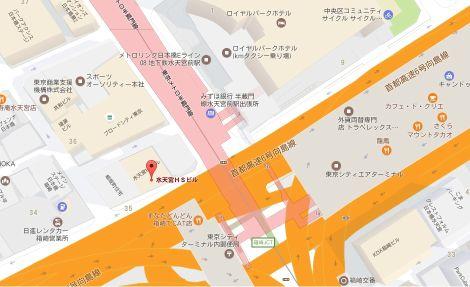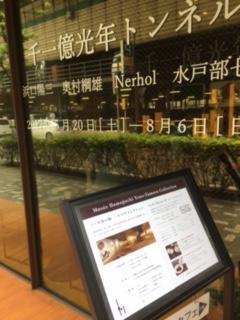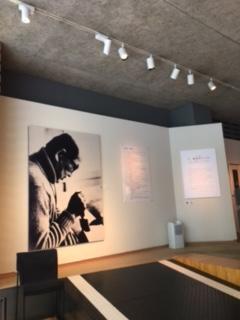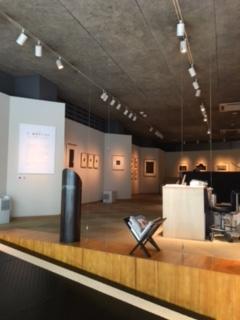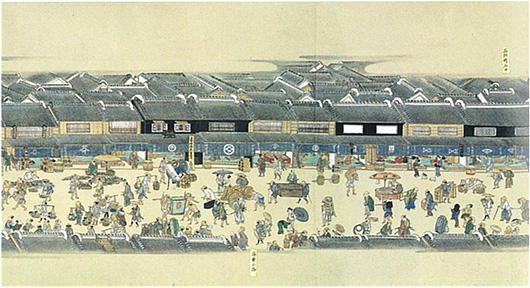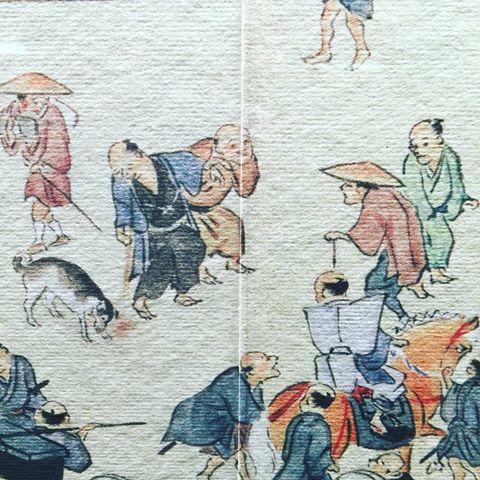On June 8, 2017, I visited the Soy Sauce Hall in Nihonbashikoamicho, but after seeing soy sauce from all over the country being displayed in plastic bottles, I left here, and 1-35-7 Nihonbashi Kakigaracho in front of the Royal Park Hotel. Yosanko Hamaguchi, the 10th generation third son of Yamasa soy sauce and a copperplate painter, at the Mizutengu HS Building. It's a soy sauce connection.
It is a museum with a hideaway atmosphere because it has been renovated from a space that served as a warehouse for Yamasa soy sauce. The first floor and the basement are the exhibition halls. Was it a soy sauce barrel in the past? Now it's a stylish interior, and the 1st and 2nd floors are connected by spiral stairs. Metropolitan Expressway Route 6 runs nearby, but you can enjoy it in a quiet atmosphere without hearing any noise at all.
Address: 1-35-7, Nihonbashikakigaracho, Chuo-ku, Tokyo
(Currently, under the title of "111 billion light-year tunnel", copperplate prints of Yozo Hamaguchi and works of young artists (Yozo Hamaguchi, Tsunao Okumura, Nerhol, Nanae Mitobe) are on display. It will be held until August 6, 2017.
Yozo Hamaguchi was born on April 5, 1909 (Meiji 42) in Hiromura, Arita-gun, Wakayama Prefecture. The Hamaguchi family has been the founder of Yamasa soy sauce that claims to be "Gibei" for generations, and Yozo is the third son of the 10th generation Gibei Hamaguchi. At Tokyo Bijutsu School (currently Tokyo University of the Arts), he enrolled in the Sculpture Department, but dropped out of school in two years and traveled to Paris, and from around 1937 (Showa 12) during his stay in Paris, he tried to create a copperplate print technique that draws a pattern directly on a copper plate with a needle, and started writing a step towards a printmaker. Hamaguchi is internationally known as a revivalr of mesotint techniques in the 20th century. Mezotint is one of the copperplate engraving techniques, also known as "Maniel Noir (black technique)" and uses a tool called "Belso" on the surface of the copper plate to make fine points on the whole surface and express subtle black shades. The black land made in this way is carved using tools called "scrapers" and "vanishers" to represent patterns and subtle shades. This technique has been cut off for a long time with the development of photography, but Hamaguchi is known for his revival of this technique and the development of the technique of "color mesotint" in which color plates are repeatedly printed. The photo on the left side below shows the tools used by Hamaguchi, and the right is the press machine used when printing after the plate is completed.
After staying abroad for a long time, I returned to Japan in 1996, and spent several years in Japan until I died in December 2000. The Muse Hamaguchi and Yamasa collections were opened in 1998.
Hamaguchi used a lot of small fruits such as grapes, cherries, walnuts, and small animals such as shells and butterflies as motifs for his work, and prefers to use a technique that makes small objects stand out in a screen structure that takes a wide space. Was. Here are some of the works exhibited as a collection. (The photos of these works were provided by the courtesy of Musee Yozo Hamaguchi and Yamasa Collection Hall. Reproduction to other places is prohibited.)
Yozo Hamaguchi "14 Cherry" 1966 Color Mezotint 52.3 x 42.4cm
Yozo Hamaguchi “Zakuro (print collection“ Hamaguchi's six original color mezzotint ”6 pieces)” 1978 Color Mezotint 11.6 x 11.5cm
Yozo Hamaguchi "Lemon of 1/4" 1976 Color Mezotint 15.5 x 15.3cm
Yozo Hamaguchi "Wamelon" 1981 Color mesotint 23.3 x 54.1cm
Muse Yozo Hamaguchi / Yamasa Collection Summer Exhibition: "11 billion light-year tunnel"
Work: Yozo Hamaguchi, Tsunao Okumura, Nerhol, Nanae Mitobe
Date: Period from May 20 to August 6, 2017
Opening hours: Weekdays from 11:00 to 17:00 / Saturdays, Sundays, and holidays from 10:00 to 17:00 (final admission 16:30).
Admission fee: 600 yen for adults / 400 yen for university and high school students / Free for junior high school students and younger
Closed days: Monday
For more information, please contact the Muse Yozo Hamaguchi / Yamasa Collection.
Tel 03-3665-0251
(The photos of these works were provided by the courtesy of Musee Yozo Hamaguchi and Yamasa Collection Hall. Reproduction to other places is prohibited.)
